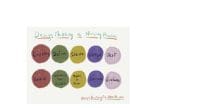The National Academies of Science, Engineering, and Medicine (NAM) released their Future of Nursing 2020–2030 report recently with a sizable nod toward nurse-led innovation in the context of health equity and the Social Determinants of Health (SDOH). The report lays the groundwork for the encouragement and support of nurses as leaders in health and healthcare innovation – something that nurses have been doing since the inception of the profession, but for which has never been fully recognized both inside and outside of nursing.
This article spotlights the references to innovation in the report and underscores the important takeaways.
As is noted in the Preface, the coronavirus pandemic shown a light on the innovative work nurses were regularly doing at the bedside to improve the health of patients and families instantaneously as the pandemic took hold. It is because of this work by nurses in the hospital setting as well as those in the classroom, the community, research labs, startups, and innovation centers that health and healthcare leaders are finally beginning to see the inherent innovative genius of nurses.
“This report’s release in 2021 comes as the United States and the world have suffered great loss, but also are buoyed by the promise of lessons learned, including witnessing the nursing profession’s commitment to health, nursing innovations that improved health care in real-time for patients and families impacted by COVID-19, and nurse-driven adaptations in education and practice that will likely drive lasting changes in both.” pg xiii
In addition to the pandemic, 2020 saw an increased movement toward racial justice and health equity. The Future of Nursing 2020–2030 report is focused on “Achieving Health Equity Through Nursing” through innovation and education.
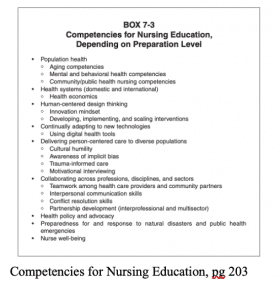

“Nurses have a rich tradition of working creatively to solve problems and improve the quality of care in clinical settings (Thomas et al., 2016), and these experiences and skills can apply to efforts designed to address SDOH. These types of initiatives require systematic, continuous, data-driven, and rigorous processes of assessment, innovation, implementation, evaluation, and diffusion or translation of the evidence or best practices into tangible strategies or policies for improving population health.” pg. 287
The future of any profession lies in the education we provide our students; in the report, the authors call for Nursing Education competencies focused on human-centered design and an innovation mindset. Though innovation is an inherent nursing skill, it will take a coordinated effort to begin to fully infuse innovation methodologies into nursing curriculums.
In the section entitled “Implications of COVID-19 for Nursing Education,” they discuss how it has been 100 years since any global event has impacted the future of nursing education like the COVID-19 pandemic. They examine exemplars of how faculty quickly innovated the way in which they educated students at the beginning of the pandemic and how those innovations will likely change how we educate our students moving forward.
“The COVID-19 pandemic has already led to innovations that are likely to shape the future of nursing education. Faculty have adopted new teaching strategies, demonstrating creativity and adaptability…These and similar innovations may ultimately guide the way to expanding and improving nursing education.” pg. 231
They also highlight the glaring disparities that emerged during the pandemic around nursing education and the inequities some students face. They call for a “sense of urgency” in adopting and modifying curriculums to meet the needs of all students for the future of nursing education.
“These challenges have underscored the limitations of traditional ways of educating nurses even as they have presented unique opportunities for innovation.” pg. 231
Innovation, education, and leadership go hand-in-hand. The Future of Nursing 2020–2030 report acknowledges nurses as leaders in health and healthcare innovation and encourages nurse leaders to support nurses as the innovators they are in their workplace. They underscore this with a focus on nursing’s work around health equity and the SDOH.
“Nurses as a professional group manifest many of the characteristics of strong leadership — including courage, humility, caring, compassion, intelligence, empathy, awareness, and accountability — that are essential to leading the way on health equity (Shapiro et al., 2006)… Increasingly, nurses are serving as innovators and codesigners of health care in their roles in the public health and health care systems (Jouppila and Tianen, 2020), and by continuing to learn and apply improvement and innovation skills, will be able to help create new care models for the decade ahead. Given the wide range of settings and roles in which nurses at all levels serve (see Chapter 1), their leadership in this regard can have broad and far-reaching impacts on equity in health and health care.” pg. 277
They continue discussing how nurses need to see themselves as the natural innovators they are to create the change necessary to eliminate disparities in health and healthcare.
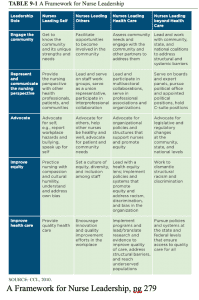

“Changing the prevailing health care paradigm to address [social determinants of health] SDOH and advance health equity will require innovation…For the complex work of eliminating disparities and impacting SDOH, knowledge, and skill in innovation will be an important competency for nurses. Nurse leaders can facilitate the creation of innovative approaches by challenging the status quo, breaking down traditional barriers to change, teaching and encouraging team members to solve problems using design thinking, identifying best practices, and facilitating the translation and adoption of new ideas, knowledge, and skill in innovation will be an important competency for nurses…” pg. 286
“Virtually all nurses have opportunities to innovate by developing new ideas for improving health and translating these ideas into practice and policy.” pg. 286
An essential factor of human-centered design, innovation, and advancing health equity is the inclusion of stakeholders (patients, families, community members) in the design process. Within the report, the authors call for nurses to co-collaborate (and co-design) with stakeholders to break down silos. This process considers the wide range of knowledge (i.e., lived experiences) of the stakeholders for whom problems affect in order to create accurate solutions as “including co-designing innovations with individuals and community representatives is a necessary component to developing, evaluating, and scaling evidence-based practice models.” pg. 372
They continue, breaking down the numerous reasons for co-collaboration:
“Collaboration across sectors is essential to break down existing silos that are counterproductive to improving health and health care (NAM, 2017). Second, collaboration among partners introduces “more expertise and knowledge than what resides in any one stakeholder group” (Wakefield, 2018), and multisector partnerships can leverage unique skills and resources from multiple stakeholders (e.g., faith leaders, philanthropists, researchers). Third, working with community partners can help nurses reach underserved populations, including the homeless, recent immigrants, and non-English-speaking families. Fourth, multisector partnerships increase a community’s capacity to make sustainable changes by bringing energy, expertise, and perspectives from multiple arenas. Fifth, multisector partnerships can simultaneously address upstream, midstream, and downstream SDOH and ensure alignment of efforts across these levels. Finally, bringing people together from multiple sectors can facilitate and encourage creative approaches; the intersections across boundaries are “where the promise of innovation lies” (Pittman, 2019, p. 27).” pg. 284
“As nurses work within and across organizations to address SDOH and advance health equity, they will need the skills to develop, engage, and lead cross-boundary teams. Cross-boundary teaming is a strategy for driving innovation that engages diverse stakeholders and subject-matter experts to expand the range of views and ideas on which teams can draw (Edmondson and Harvey, 2018. In cross-boundary teams, individuals work across knowledge boundaries. Teams are diverse in expertise, knowledge, and educational background, characterized by deep-level differences or what Edmondson and Harvey call “knowledge diversity (p. 3480).” pg. 287
The report notes that not all nurses are afforded the same support and opportunities to innovate, calling on nurse leaders to “create an environment that allows for innovation.” As was mentioned, they recommend that competencies in human-centered design and design thinking should begin to be integrated into both nursing education and the workforce.
“Yet, while some nurses are already leading efforts focused on health equity in their work settings and communities, this focus is not consistent across the profession. It is a leader’s responsibility to create an environment that allows for innovation (IOM, 2000). Leaders can provide a forum for continual innovation in and testing of strategies for improving population health and health equity and ensure that their organization is flexible and able to adapt to those changes (IOM, 2001).” pg. 286
Though the Future of Nursing 2020–2030 report explicitly calls out mobile technology and mHealth as a “growing field of innovation study and research,” it should be noted that innovation is not solely technology-based. Innovation includes the methods we use to solve problems, the processes and systems created, and how we communicate. Innovation includes technological innovations, but it also includes education, processes, systems, and much more.
The report’s first recommendation calls for nurses to “have an orientation toward innovation…”. Innovation is called out again in Recommendation 9 to support research examining “the impact of nursing interventions” related to the SDOH and health equity. Within this recommendation, they also call for community partnerships, another acknowledgment of the need for co-collaboration.
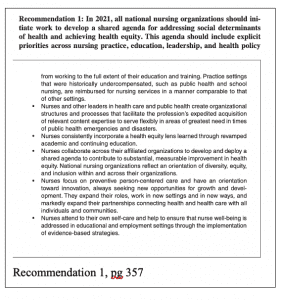

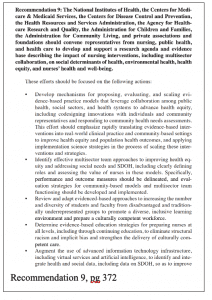

Many questions are posed in the report ranging from the educational needs of nurses related to innovation to what determines a successful innovation process. Questions that will need to be addressed and answered over the next ten years if the nursing profession is to advance and lead in health and healthcare innovation.
Agenda for Nursing Health Services Research: “What are the innovations in training RNs for careers in primary care? How can effective innovations be replicated?” pg 92
Help Control Healthcare Spending, Reduce Costs, and Increase the Value of Nurses’ Contribution to Health and Health Care Delivery: “What are examples of successful nurse-led innovations that improve the value of health care? What are the outcomes of such innovations? What are the elements of successful innovation models?” pg 93
It should be noted that the innovation movement was already beginning to take hold in the profession, even before the Future of Nursing 2020–2030 report was being conceived; from groups such as the American Nurses Association with the creation of their Innovation Board, as well as the advent of the Society of Nurse Scientists, Innovators, Entrepreneurs, and Leaders (SONSIEL), along with companies such as Johnson & Johnson showcasing nurses as innovators. Additionally, educational opportunities and programs such as the University of Pennsylvania School of Nursing and the Rita and Alex Hillman Foundation’s program Design Thinking for Health, the Drexel University/SONSIEL Nursing Innovation and Entrepreneurship certificate program and the Hillman Scholars in Nursing Innovation program— as well as many nurse-focused hackathons, incubators, and accelerator programs, provide nurses with access to essential innovation and entrepreneurship educational resources and opportunities.
As the report notes:
“Nurses focus on preventive person-centered care and have an orientation toward innovation, always seeking new opportunities for growth and development.” pg 2
“Even so, educational institutions and health systems can better prepare and empower new and practicing nurses, including licensed practical nurses, registered nurses, advanced practice registered nurses, and those with doctoral degrees to develop and grow in leadership roles.” pg 275
Therefore, encouraging nurses to participate in innovative programs and educational opportunities will allow innovation to flourish in the profession, and ultimately create the change needed “…in clinical care, nurse education, nursing leadership, and nursing-community partnerships…” both “as a result of the pandemic” but also due to the foundational work championed by many Universities and organizations.
In closing, as the NAM Future of Nursing 2020–2030 report suggests, the future of nursing — and the future of equitable care — centers on the notion that the profession of nursing: students, educators, clinicians, researchers, entrepreneurs, public health practitioners, and other nurse leaders need to embrace an innovation mindset and begin to fully integrate innovation methodologies, resources, and opportunities into their curriculums and workplaces. It is up to all of us in nursing to embrace these recommendations and move toward a more innovative and equitable future.
National Academies of Sciences, Engineering, and Medicine 2021. The Future of Nursing 2020-2030: Charting a Path to Achieve Health Equity. Washington, DC: The National Academies Press. https://nam.edu/publications/the-future-of-nursing-2020-2030/






